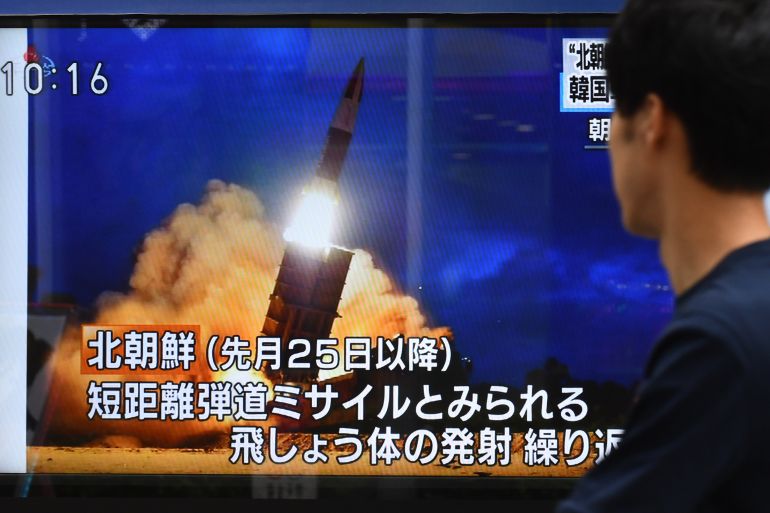North Korea launches missile after warning about military drills
Saturday’s launch comes before upcoming US-South Korea joint drills in Washington next week.

North Korea launched a long-range ballistic missile into the sea off Japan’s west coast after warning of a strong response to upcoming military drills by South Korea and the United States.
Japanese authorities said the missile plunged into waters on Saturday inside Japan’s exclusive economic zone (EEZ), more than an hour after it was launched, suggesting the weapon was one of Pyongyang’s largest missiles.
“North Korea fires an unidentified ballistic missile into [the] East Sea,” South Korea’s Joint Chiefs of Staff said, referring to the body of water also known as the Sea of Japan.
Denouncing the launch as a “clear breach of UN Security Council resolutions”, the joint chiefs of staff said the missile had flown about 900km (560 miles) before splashing into the sea.
Japanese government spokesman Hirokazu Matsuno told reporters that North Korea fired an “ICBM-class ballistic missile” to the east, referring to long-range intercontinental ballistic missiles that Pyongyang has increasingly tested.
Japanese Prime Minister Fumio Kishida said the missile appeared to have landed “within Japan’s EEZ, west of Hokkaido”.
“It is an escalating provocation against the international community as a whole, and naturally we severely lodged a protest against it,” he added.
Japanese officials said there were no immediate reports of damage to ships or aeroplanes.
South Korean officials, meanwhile, said the “presumed long-range missile” was launched from the Sunan area near Pyongyang. Sunan is the site of the Pyongyang International Airport, where North Korea has conducted most of its recent ICBM tests.
Following Saturday’s launch, South Korea’s National Security Council convened a meeting and agreed to increase cooperation on security with Washington and Japan.
The US Indo-Pacific Command said in a statement that US commitments to the defence of Japan and South Korea “remain ironclad”.
“While we have assessed that this event does not pose an immediate threat to US personnel, or territory, or to our allies, we will continue to monitor the situation,” the statement added.
The White House strongly condemned the launch and said it would take all necessary measures to protect the US homeland and regional allies.
The launch “needlessly raises tensions and risks destabilizing the security situation in the region,” Adrienne Watson, spokesperson for the White House National Security Council, said in a statement.
The launch came a day after North Korea’s foreign ministry threatened to take “unprecedentedly” strong action against South Korea after it announced planned military exercises.
The North Korean statement on Friday accused Washington and Seoul of planning more than 20 rounds of military drills this year, including large-scale field exercises, and described its rivals as “the arch-criminals deliberately disrupting regional peace and stability”.
The US tabletop exercise, scheduled for Wednesday, would set up possible scenarios in which North Korea uses nuclear weapons and would explore how to cope with them militarily and formulate crisis management plans, South Korea’s defence ministry has said.
“With a focus on North Korea’s nuclear threats, both sides will have in-depth discussions on various measures to strengthen US extended deterrence, including information sharing and consultation procedures,” the ministry said in a statement.
Heo Tae-keun, South Korea’s deputy minister of national defence policy, also told legislators on Friday the two countries would hold joint field exercises in mid-March that would be bigger than those held in the past few years. The exercises are expected to include live-fire drills.
The latest launch followed a record year for North Korean weapons demonstrations, with Pyongyang firing more than 70 ballistic missiles, including ICBMs with the potential range to reach the US mainland.
North Korea has also conducted several launches it described as simulated nuclear attacks against South Korean and US targets, while passing a law that declared the country an “irreversibly” nuclear state.
Al Jazeera’s defence editor Alex Gatopoulos said that these missiles were real weapons tests that are increasing in sophistication.
“The missile did not travel that far, but it travelled extremely high – fourteen times higher than an ISS. It is an effective weapon that can deliver possibly a nuclear weapon if they so decide.”
The increased activity from Pyongyang has met ramped-up joint military drills from South Korea and key allies.
That followed a scaled-back period amid the COVID-19 pandemic, as well as a fruitless diplomatic offensive by former US President Donald Trump.
Some 28,500 US troops are stationed in South Korea as a legacy of the 1950-1953 Korean War, which ended in an armistice rather than a full peace treaty, leaving the countries technically still at war.
Saturday’s launch marked the first detected from North Korea since January 1.
Last November, a missile fired by Pyongyang was also believed to have landed in Japan’s EEZ.